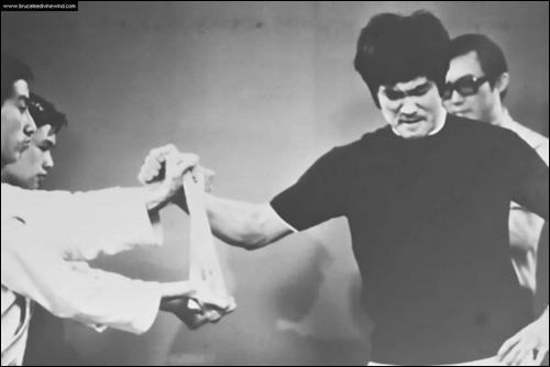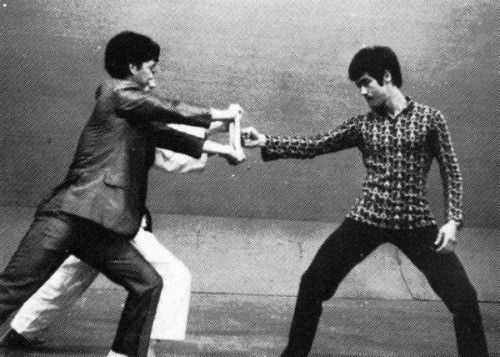Scientific explanation for Bruce's legendary 1-inch punch
Bruce did the best technique. The right to make a wooden board break in a distance of 1 inch made the whole world admire.
- Bruce Lee's martial arts legend and 15 secrets surprised many people
- Continuous push of 1,500 is only one of 10 world records that no one has ever broken of Bruce
Bruce Lee (November 27, 1940 - July 20, 1973) is a martial arts legend, a world famous actor. He was the most successful performer of the "Best right" punch with an attack range of only 1 inch (equivalent to 2.54 cm) and still dealt great damage.
How did Bruce make the legendary punch?
Associate Professor of Orthopedic Surgery Jessica Rose at Stanford University has spent a lot of time researching Bruce Lee's famous "1-inch punch". According to her, this punch was made thanks to a special neural structure, not just normal muscle strength.
Bruce made this punch thanks to the ability to coordinate a series of complex movements throughout the body and the exact time of action.

When making a 1-inch punch, Bruce's legs and hind legs stretched out in an extremely fast way thanks to his knee, and his hips also rotated at high speed, his right shoulder (punched) jerked. forward. His hand was pulled back immediately after the piece of wood was punched. The shorter the duration of the punch force is, the more force is contained and the stronger the punch.
In just a few seconds, the largest muscle groups throughout Bruce Lee's body combined to create a legendary punch. Every joint and muscle are accelerating in just a moment, all the parts involved in the movement must reach a peak almost at the same time.
In 2012, Ed Roberts, a neuroscientist at Imperial College London, conducted a study to compare the strength of punches within 2 inches between karate masters and those with similar muscle mass. but not practicing martial arts.
After sweeping the brain activity of volunteers, Roberts discovered the link between strength and coordination in the martial world with the microstructure of white matter in the brains of martial arts practitioners when they performed the attack. similar to Bruce Lee's punch. Specifically, the brain region responsible for coordinating movement between muscles and the white matter content of the boxers allows them to perform very complex connections, thereby enhancing the ability to synchronize when performing the martial position. .
From a neurological perspective, the development of white matter in the brain is due to the flexibility of nerve cells (neuroplasticity - a brain ability to re-link to match new requirements). The more martial arts practitioners practice the martial arts requires the use of the body, the more white matter is added to the motor lobes to meet the requirements of the muscles.
According to Robert's research, Bruce Lee's white matter development is higher than normal, which is the result of his hard work and continuous training throughout his life.

How much energy does 1 inch punch transmit?
Authors of Fighting Science: The Laws of Physics for Martial Artists relied on Bruce Lee's performances to calculate the amount of kinetic energy the punch had infused participants in performances.
First, they formulated the formula for sliding friction force when the chair started to move, with default conditions such as the weight of the chair was negligible, the mass of the bearer was about 60kg and the coefficient of sliding friction between chair with floor is 0.5. Since then, they have introduced the formula for calculating friction force:
Sliding friction force = Perpendicular force between two objects (here is the seat + person compared to the floor) x Friction coefficient = Weight x Gravity acceleration x Coefficient of friction = 60 x 9.8 x 0, 5 = 294 Newton
According to estimates, the chair slipped about 1 meter, so the kinetic energy needed for the chair to slide with that distance or is the total amount of energy that the punch has been transmitted to the bearer is calculated by the formula.
Kinetic energy = Impact force (here is sliding friction force) x Moving distance = 294 x 1 = 294 Jun
So, the kinetic energy that Bruce's 1-inch punch emits is 294 Jun, while the kinetic energy of the 9x19 mm Parabellum bullet when leaving the barrel is about 458 Jun. Since then, we can see the danger level of Bruce's 1-inch punch and explain why it can break the piece of wood in a split second.
You should read it
- How to download Dragon Ball Legends iOS game, Android version 2018
- 100+ Best dragon tattoo templates today
- Code Dragon Waifu Latest Dragon Hunter and how to enter the code
- Tips to improve your base in Dragon Quest Builders 2
- Configure Dragon Ball: Kakarot PC
- Dragon City Overview - How to download Dragon City on your computer
- Komodo assassin dragon slayed a giant buffalo buffalo with a cup
- How to play Dragon Quest Tact for newbies
May be interested
- How to get an explanation of the command in a terminal with Kmdr
 once you know what a command does, you can use it freely in the future. if you're struggling with linux commands, you can use the kmdr tool to explain them.
once you know what a command does, you can use it freely in the future. if you're struggling with linux commands, you can use the kmdr tool to explain them. - 16-inch MacBook Pro launched, replacing the 15-inch version, priced from $ 2399
 apple has just officially announced the new macbook pro with a larger 16-inch screen and fixes a number of issues that users complain about in the older generation.
apple has just officially announced the new macbook pro with a larger 16-inch screen and fixes a number of issues that users complain about in the older generation. - Legendary Windows XP operating system - who still remembers?
 windows xp used to be the operating system attached to the 8x and 9x generations. the photos below the wire will surely bring an unforgettable memory of the legendary name of that time.
windows xp used to be the operating system attached to the 8x and 9x generations. the photos below the wire will surely bring an unforgettable memory of the legendary name of that time. - Top 5 best 15 inch laptops 2020
 15-inch laptops are neither too big nor too small, they are reasonably sized. the following is a list of the best 15-inch laptops 2020.
15-inch laptops are neither too big nor too small, they are reasonably sized. the following is a list of the best 15-inch laptops 2020. - How to install the legendary Alliance on Linux
 the legendary alliance is still one of the most famous moba games in the world. although this game has been around for a while and has a huge number of players, it has never appeared on linux.
the legendary alliance is still one of the most famous moba games in the world. although this game has been around for a while and has a huge number of players, it has never appeared on linux. - The top 10 'inventive' scientific inventions that are great
 according to the ancient greek philosopher plato, science is a feeling, here are 10 scientific discoveries that all come from sentiment.
according to the ancient greek philosopher plato, science is a feeling, here are 10 scientific discoveries that all come from sentiment. - How to get Pajamas Saitama costume in Free Fire
 as part of a free fire x one punch man collaboration, garena added the pajamas saitama outfit as a new diamond royale bonus, an exclusive bonus a lot of gamers want to own.
as part of a free fire x one punch man collaboration, garena added the pajamas saitama outfit as a new diamond royale bonus, an exclusive bonus a lot of gamers want to own. - Learn about 100 inch, 120 inch, 150 inch projection screens
 how is the screen size of 100 inch, 120 inch, 150 inch screens? should i choose the most suitable presentation and entertainment?
how is the screen size of 100 inch, 120 inch, 150 inch screens? should i choose the most suitable presentation and entertainment? - The 12-inch Macbook Air will have 3 colors like the iPhone 5S
 according to mashable, the macbook air model that uses a 12-inch screen is rumored to have been announced by the apple house in the summer of 2015. in particular, this model has 3 different colors. .
according to mashable, the macbook air model that uses a 12-inch screen is rumored to have been announced by the apple house in the summer of 2015. in particular, this model has 3 different colors. . - 10 signs that you are extremely boring and boring
 let us review 10 identification signs that are summarized on business insider page to see if you are a boring, boring person.
let us review 10 identification signs that are summarized on business insider page to see if you are a boring, boring person.










 Discovering 20 great uses of Coca Cola you may not know
Discovering 20 great uses of Coca Cola you may not know Detecting new particulate matter 4 times heavier than proton
Detecting new particulate matter 4 times heavier than proton If you can open the plane in mid-air you will be a superman and this is why
If you can open the plane in mid-air you will be a superman and this is why This is the first GIF image to be stored on a microbe
This is the first GIF image to be stored on a microbe The picture of the strange and controversial bridge over the past, the waste of idiots or constructive calculation
The picture of the strange and controversial bridge over the past, the waste of idiots or constructive calculation This is the world's most rare passport, only 3 people in the world own it
This is the world's most rare passport, only 3 people in the world own it